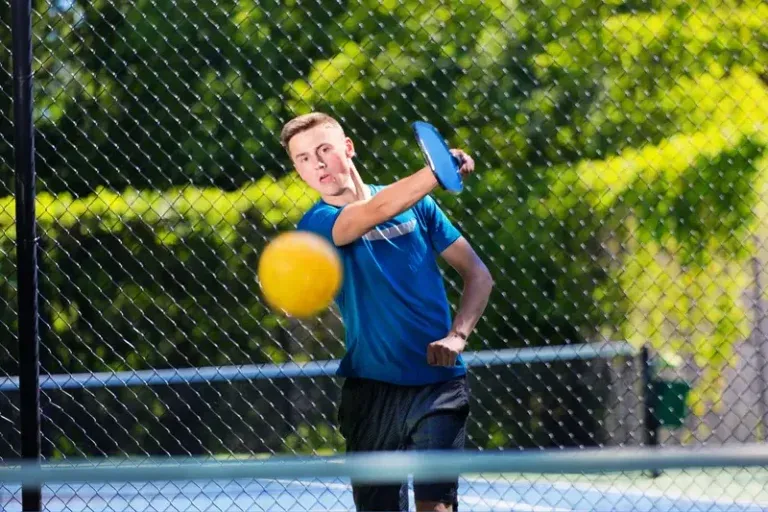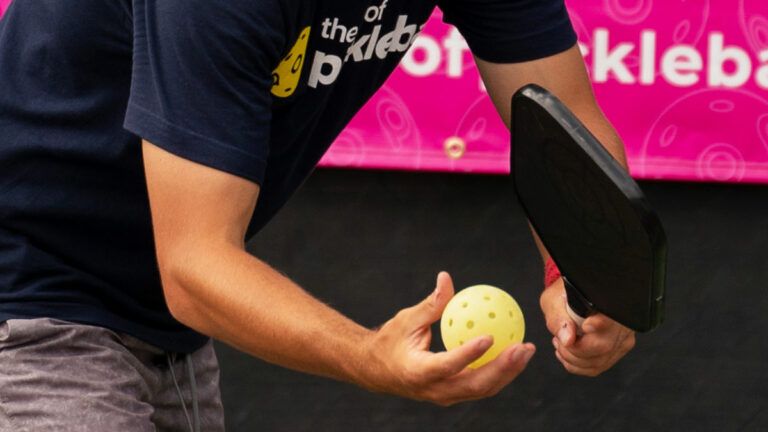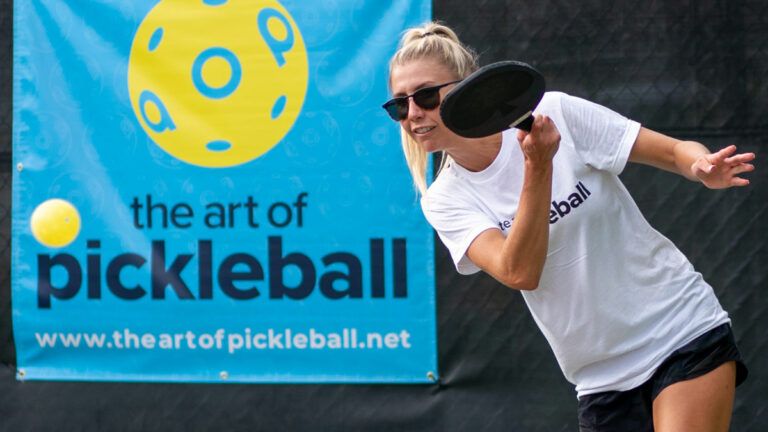Understanding Pickleball Spin Serves
What is a Spin Serve?
The spin serve in pickleball is a specialized serving technique that employs different spins to create unpredictable trajectories, making it particularly challenging for opponents to return the ball effectively. Legal under the United States Pickleball Association (USAPA) rules, the spin serve can take various forms depending on the type of spin applied, and it transforms an ordinary serve into a tactical weapon. Whether a novice or an experienced player, understanding these nuances can significantly enhance one's gameplay.
The magic of the spin serve lies in its ability to fool opponents, akin to a magician's sleight of hand. Just as a master magician uses misdirection to captivate and surprise, spin serves play with the opponent's expectations, turning a simple game of ping-pong into a thrilling, unpredictable contest. The strategic use of spin transforms the game's rhythm, as players must not only react quickly but also anticipate and adapt to the unpredictable bounce and trajectory of the spinning ball.

The Science Behind Spin
Understanding the physics of spin is crucial for executing an effective serve. When a pickleball is struck with different spins, it reacts distinctly upon contact with the ground. Each spin influences the ball's bounce, speed, and trajectory:
- Topspin: This type of spin causes the ball to dip quickly after crossing the net, resulting in a higher bounce that can catch receivers off guard.
- Backspin: Conversely, backspin creates a lower bounce, often described as a "floating" effect, making it hard for opponents to capitalize on.
- Sidespin: This spin causes the ball to curve to the left or right, challenging players to reposition and adjust to unexpected ball movement.
Advantages of Using Spin Serves
The benefits of incorporating spin serves into a pickleball strategy are numerous, akin to having several aces up your sleeve during a card game. Some key advantages include:
- Unpredictability: The variable trajectories keep opponents guessing, forcing them into reactive gameplay.
- Setting Up Offensive Plays: Spin serves can create advantageous positions on the court, allowing players to dictate the pace of play.
- Exploiting Opponents’ Weaknesses: A well-placed spin serve can target specific weaknesses in an opponent's game, such as difficulty returning backspin serves.
By seamlessly integrating these spins into their gameplay, players can transform a standard serve into a powerful strategy, enhancing their overall competitiveness on the court.
Types of Pickleball Spin Serves

Topspin Serve
Executing a topspin serve requires precise mechanics and an understanding of the paddle's motion and grip. This serve causes the ball to dip quickly after crossing the net, resulting in a higher bounce that can deceive the opponent.
- Technique: To perform a topspin serve effectively, players should start with their paddle low and swing upward while brushing the top front part of the ball.
- Contact Point: Making contact with the ball at its center or just below is crucial for generating the right spin.
- Follow-Through: A proper follow-through not only enhances the spin but also contributes to the ball's acceleration.
Benefits of the Topspin Serve
The topspin serve is fast and aggressive, often catching opponents off-guard. Here's a closer look at its benefits:
- Fast Bounce: The quick dip and high bounce create a formidable challenge for opponents.
- Aggressive Play: This type of serve can lead to aggressive net play, setting up opportunities for winners.
Sidespin Serve
The sidespin serve adds an extra layer of complexity to gameplay. This serve can take one of two forms: the banana serve and the screwball serve.
- Banana Serve: An outward curve allows players to target their opponent’s backhand, creating difficulties in returning the ball.
- Screwball Serve: This serves with an inward curve can throw opponents off balance, forcing errors.
Both of these serves create unpredictable movements and can turn the tide within a match, allowing players to strategically exploit weaknesses in their opponents' return skills.
Backspin Serve
A backspin serve presents its own set of challenges and is particularly effective against opponents who struggle with low balls:
- Execution: Hitting underneath the ball with a scooping motion creates the necessary backward spin.
- Challenges: This serve requires precise execution to avoid faults associated with downward motion restrictions.
The backspin serve is often likened to a well-aimed shot in a game of billiards a calculated risk where the outcome can significantly impact gameplay.
Mastering the Fundamentals of Spin Serves

The Importance of Grip
Mastering the correct grip is fundamental to executing effective spin serves. The most common grip for generating different spins is the continental grip, which allows for versatile paddle movement. Players may also explore:
- Semi-Western Grip: Provides excellent topspin capability.
- Backhand Eastern Grip: Suitable for effectively applying sidespin.
Paddle Motion and Contact Point
Appropriate paddle motion is crucial for generating the desired spin. For example, brushing the ball with the paddle during a swing path can create topspin or sidespin, while cutting underneath can create backspin.
Developing Wrist Action: Shea Underwood's Five-Minute Drill
Building wrist action is essential for spin generation. Shea Underwood’s five-minute drill focuses on:
- Finger Snap Technique: Enhances the control and spin of the ball.
- Wrist Snap for Spin: Allows players to generate a more dynamic serve.
This drill encourages players to focus on their wrist movement, making spin serves more natural and effective.
Advanced Spin Serve Techniques
The Air Bender Serve
One of the more advanced techniques, dubbed the Air Bender Serve, involves a high-arcing topspin serve that confuses opponents with its unpredictable bounce and trajectory. As Kuang Dang demonstrated, this serve can lead to significant advantages during critical points in a match.
Mixing Spin Variations for Tactical Advantage
Mixing spin serves creates a rich tapestry of serves that keep opponents off-balance. By varying spins, players can disrupt timing and maintain the upper hand. A serve strategy that includes topspin followed by backspin can be particularly disorienting, leading to unexpected returns.
Dominant vs. Non-Dominant Hand Snapping Techniques
Exploring one-handed and two-handed spin serves can add more depth to a player’s skill set. Cleaner execution with the dominant hand often creates a more controlled spin, while utilizing both hands can produce surprising angles, enhancing unpredictability.
Strategic Application of Spin Serves
- Targeting Opponents' Weaknesses: Successful spin serves exploit opponents' weaknesses be it a slower backhand return or difficulty with low-bouncing shots. Understanding these vulnerabilities allows players to craft serves that target specific areas of their opponent's skill set.
- Using Spin Serves as Change-Ups: Spin serves can be used as tactical surprises during a match, disrupting opponents' timing. Just as a pitcher uses a change-up to keep batters guessing, players can utilize well-timed spin serves to shift momentum.
- Creating Pressure and Opening the Court: Effective spin serves can force weaker returns, allowing players to dictate the pace of play and create openings. For instance, a well-placed topspin serve can cause an opponent to hesitate, leading to a coveted opportunity for a decisive shot.
Practicing and Perfecting Spin Serves
Wall Drills for Spin and Consistency
Solo wall drills are an excellent method for honing spin serves. Players can practice different types of spin, receiving instant feedback through the ball's rebound and adjusting technique accordingly.
Line Drills for Directional Control
Setting up lines on the court can help players focus on directional control while serving. Practicing consistently improves overall serving accuracy and efficiency.
Target Practice: Serving to Specific Zones
Engaging in target practice helps develop the skills necessary to serve with precision. Players can set up zones to aim at, replicating pressure scenarios faced during matches.
Troubleshooting Common Spin Serve Problems
- Inconsistent Spin: Diagnosing grip errors and correcting paddle motion can often address issues with inconsistent spin. Players should assess their grip and ensure they maintain the correct paddle position throughout the serve.
- Serving into the Net: Adjusting the trajectory and aiming higher can mitigate the fear of hitting into the net. By focusing on elevation during their serve, players can improve execution and confidence.
- Lack of Power or Distance: Generating power is crucial and can be achieved through effective load-up techniques. Utilizing proper body mechanics during the serve will translate to greater distance and spin.
Equipment Considerations for Spin Serves
The Role of Paddle Grit
The grit of a paddle can significantly affect spin generation. A paddle with optimal texture allows for better ball contact, improving spin effectiveness.
Choosing the Right Paddle for Your Spin Serve Style
Selecting the right paddle tailored to a player’s playing style is critical. Players should consider paddle reviews and recommendations that align with their spin serve preferences.
Staying Up-to-Date on Spin Serve Rules
The Evolution of Spin Serve Rules
As the sport continues to evolve, so too do the rules governing spin serves. Staying updated on any changes in the USAPA rulebook ensures players remain compliant while maximizing their strategic options.
Ensuring Your Spin Serves are Legal
Understanding legal spin techniques is crucial for avoiding faults. Players should familiarize themselves with the specific rules regarding serve execution to maintain fairness during gameplay.
Spin Serves for Different Skill Levels
Beginner's Guide to Spin Serves
Novice players can start by developing basic spin techniques, focusing on simple grips and paddle motions. As players cultivate confidence, they can integrate spins into their gameplay more seamlessly.
Intermediate: Adding Variation and Consistency
Intermediate players should work on enhancing their spin repertoire, focusing on consistent placements and variations in spin to keep opponents on their toes.
Advanced: Mastering Techniques and Strategy
Elite players delve into sophisticated spin serves, combining tactical applications and advanced mechanics to gain an upper hand, drawing inspiration from professional pickleball strategists.
As we conclude our exploration of the intricate world of spin serves in pickleball, it becomes clear that mastering these techniques requires a blend of skill, focus, and perseverance. Each type of spin offers unique challenges and advantages, allowing players to become formidable competitors on the court. As the game evolves, embracing these strategies ensures players not only stay ahead of the curve but also enrich their pickleball experience. Whether you are a beginner or an advanced player, the keys to success with spin serves lie in dedicated practice, keen observation, and a willingness to adapt, ensuring your place in the dynamic narrative of pickleball excellence.










